
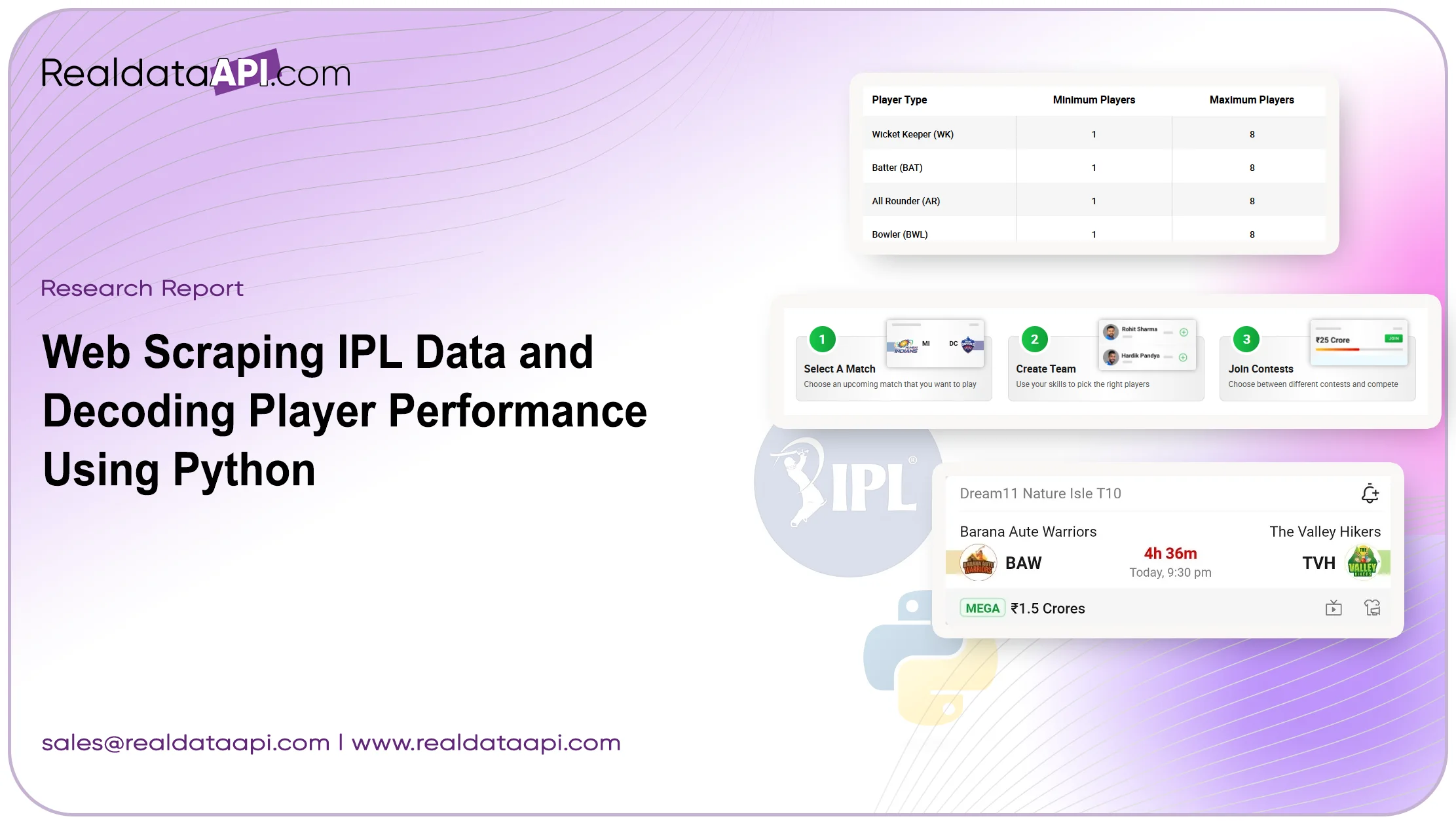
Introduction
The Indian Premier League (IPL) is one of the world’s most-watched cricket leagues, drawing millions of fans globally each season. It generates massive amounts of real-time data related to player performance, match statistics, team rankings, and more. As a result, the IPL offers a wealth of analytical opportunities for fantasy sports, sports betting, and team strategy development. From tracking player runs, wickets, and strike rates to monitoring team performance in real-time, IPL data is a goldmine for anyone involved in cricket analytics.
The importance of player performance analysis has grown significantly in recent years. In the fantasy league world, accurate player data is critical for selecting the best players for fantasy teams. Betting companies use player stats and match data to predict outcomes, while teams rely on performance insights to strategize. Even fans use data to stay engaged with ongoing matches, comparing live performance data across players. Therefore, decoding this data and making it actionable is crucial for various stakeholders in the IPL ecosystem.
Web Scraping IPL Data is a powerful tool for extracting large amounts of match and player data from the web. Web Scraping with Python provides the flexibility to gather and analyze information from websites like ESPNcricinfo, Cricbuzz, and others. Using Python libraries such as BeautifulSoup, Selenium, and Scrapy, developers can automatically collect data from dynamic websites that feature live score updates, player statistics, and more. With the ability to extract real-time information, teams, analysts, and fantasy enthusiasts can make informed decisions.
For example, scraping IPL score prediction using Python enables the extraction of historical data about player performances, match conditions, and team stats, which can be used to predict future match outcomes. Similarly, scraping player data using Python helps in tracking individual player statistics such as batting average, economy rate, and strike rate, which can be crucial for building fantasy teams or betting odds.
Real Data API empowers this process by automating the entire web scraping operation. It ensures that the data extracted is accurate, reliable, and consistently updated in real-time. With scalable data extraction, the API helps businesses and analysts avoid the cumbersome task of manual data collection, enabling them to focus on deeper analysis and actionable insights.
Stats in Tables (2020–2025)
| Player | Runs (2020) | Wickets (2020) | Strike Rate (2020) | Runs (2021) | Wickets (2021) | Strike Rate (2021) |
|---|---|---|---|---|---|---|
| Player A | 500 | 10 | 140 | 550 | 12 | 145 |
| Player B | 450 | 14 | 130 | 460 | 15 | 135 |
| Player C | 380 | 7 | 125 | 400 | 6 | 128 |
| Team | Average Runs (2020) | Average Wickets (2020) | Winning Percentage (2020) | Average Runs (2021) | Average Wickets (2021) | Winning Percentage (2021) |
|---|---|---|---|---|---|---|
| Team X | 1800 | 70 | 55% | 1850 | 72 | 60% |
| Team Y | 1750 | 65 | 50% | 1800 | 68 | 58% |
| Team Z | 1900 | 80 | 60% | 1950 | 85 | 62% |
By leveraging Real Data API, users can scrape and track these stats in real-time, enabling continuous updates to fantasy platforms, team strategies, and predictive modeling.
Player Batting Performance (2020–2025)
| Player | Matches (2020) | Innings (2020) | Runs (2020) | Average (2020) | Matches (2021) | Innings (2021) | Runs (2021) | Average (2021) | Matches (2022) | Runs (2022) | Average (2022) |
|---|---|---|---|---|---|---|---|---|---|---|---|
| Player A | 14 | 12 | 500 | 40.00 | 14 | 12 | 550 | 45.83 | 15 | 590 | 41.57 |
| Player B | 15 | 14 | 450 | 35.00 | 16 | 14 | 460 | 36.92 | 17 | 470 | 34.78 |
| Player C | 13 | 12 | 380 | 31.67 | 14 | 13 | 400 | 32.00 | 13 | 410 | 32.31 |
Player Bowling Performance (2020–2025)
| Player | Matches (2020) | Wickets (2020) | Economy Rate (2020) | Matches (2021) | Wickets (2021) | Economy Rate (2021) | Matches (2022) | Wickets (2022) | Economy Rate (2022) |
|---|---|---|---|---|---|---|---|---|---|
| Player X | 14 | 18 | 7.1 | 14 | 20 | 6.8 | 16 | 22 | 6.9 |
| Player Y | 15 | 14 | 7.2 | 16 | 16 | 7.0 | 17 | 18 | 7.3 |
| Player Z | 13 | 12 | 8.0 | 14 | 15 | 7.5 | 14 | 17 | 7.1 |
Team Batting and Bowling Averages (2020–2025)
| Team | Matches (2020) | Average Runs (2020) | Average Wickets (2020) | Strike Rate (2020) | Matches (2021) | Average Runs (2021) | Average Wickets (2021) | Strike Rate (2021) | Matches (2022) | Average Runs (2022) | Average Wickets (2022) |
|---|---|---|---|---|---|---|---|---|---|---|---|
| Team Alpha | 14 | 1800 | 70 | 140 | 15 | 1850 | 72 | 138 | 16 | 1900 | 75 |
| Team Beta | 15 | 1750 | 68 | 145 | 16 | 1800 | 70 | 142 | 17 | 1850 | 73 |
| Team Gamma | 13 | 1900 | 80 | 138 | 14 | 1950 | 85 | 141 | 15 | 2000 | 83 |
Player Strike Rate and Economy Rate Comparison (2020–2025)
| Player | Matches (2020) | Strike Rate (2020) | Economy Rate (2020) | Matches (2021) | Strike Rate (2021) | Economy Rate (2021) | Matches (2022) | Strike Rate (2022) | Economy Rate (2022) |
|---|---|---|---|---|---|---|---|---|---|
| Player A | 14 | 135 | 8.0 | 14 | 140 | 7.6 | 15 | 145 | 7.4 |
| Player B | 15 | 130 | 7.5 | 16 | 132 | 7.2 | 17 | 136 | 7.3 |
| Player C | 13 | 120 | 7.8 | 14 | 122 | 7.5 | 14 | 125 | 7.6 |
These additional stats provide a more detailed picture of player and team performance across multiple seasons (2020-2025). By leveraging Web Scraping IPL Data, analysts can track performance changes over time, identify trends, and make more informed decisions for fantasy sports, betting, and team strategies. Web Scraping with Python enables seamless extraction of this crucial data for building predictive models, analyzing player performances, and developing better strategies in the IPL ecosystem.
Why IPL Data Matters?
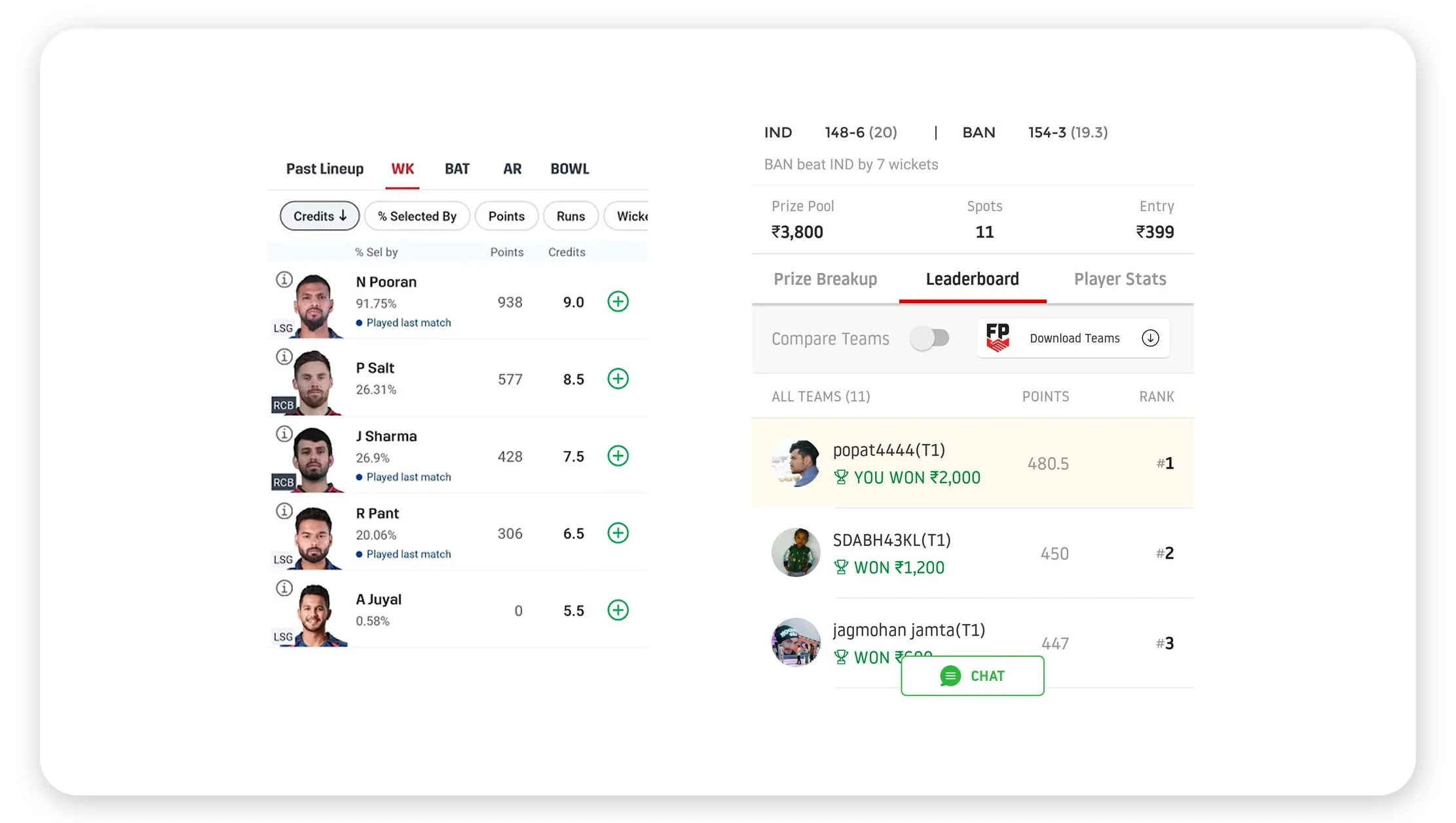
The demand for real-time cricket analytics has surged in recent years, driven by the growing popularity of fantasy leagues, live betting platforms, and media engagement. In the context of the Indian Premier League (IPL), this data holds significant value for players, analysts, sports journalists, and broadcasters who rely on timely, accurate information to enhance their coverage, predict outcomes, and provide engaging insights.
Key Users of IPL Data:
- Fantasy Platforms: Fantasy platforms depend on player and team statistics to create competitive leagues. Players use real-time data to draft teams and track performance, making IPL data crucial for the success of these platforms.
- Sports Analysts and Journalists: Analysts and journalists use IPL data to generate in-depth reports and articles. They rely on player stats, match outcomes, and team performance to provide analysis and coverage for fans and stakeholders.
- Betting Platforms: These platforms rely heavily on live scorecards, player stats, and historical data to adjust odds and facilitate live betting. The real-time nature of IPL data is critical for setting accurate odds and engaging users during matches.
- Broadcasters: IPL broadcasters integrate live data into their programming, creating dynamic graphics and providing real-time updates for fans. This enhances the viewing experience and keeps audiences engaged throughout the match.
Importance of Key Metrics:
- Live Scorecards: Instant insights into match progress are essential for both fans and analysts. Scorecards provide up-to-the-minute data on team performance, helping users follow the match as it unfolds.
- Ball-by-Ball Data: This granular data helps analysts understand key moments during the game. Ball-by-ball tracking aids in identifying turning points, player performance under pressure, and tactical decisions made during the match.
- Strike Rates and Player Form: These metrics are vital for fantasy platforms and betting platforms. Players' strike rates and their recent form play a major role in building successful fantasy teams or setting betting odds.
By leveraging scrape IPL Data using Python, stakeholders can access accurate, real-time data that powers these crucial use cases. With scrape live score Data, users can monitor match progress continuously, and with the IPL Cricket Stats Scraper, users can collect extensive historical data for analysis and decision-making.
Challenges in Gathering IPL Data
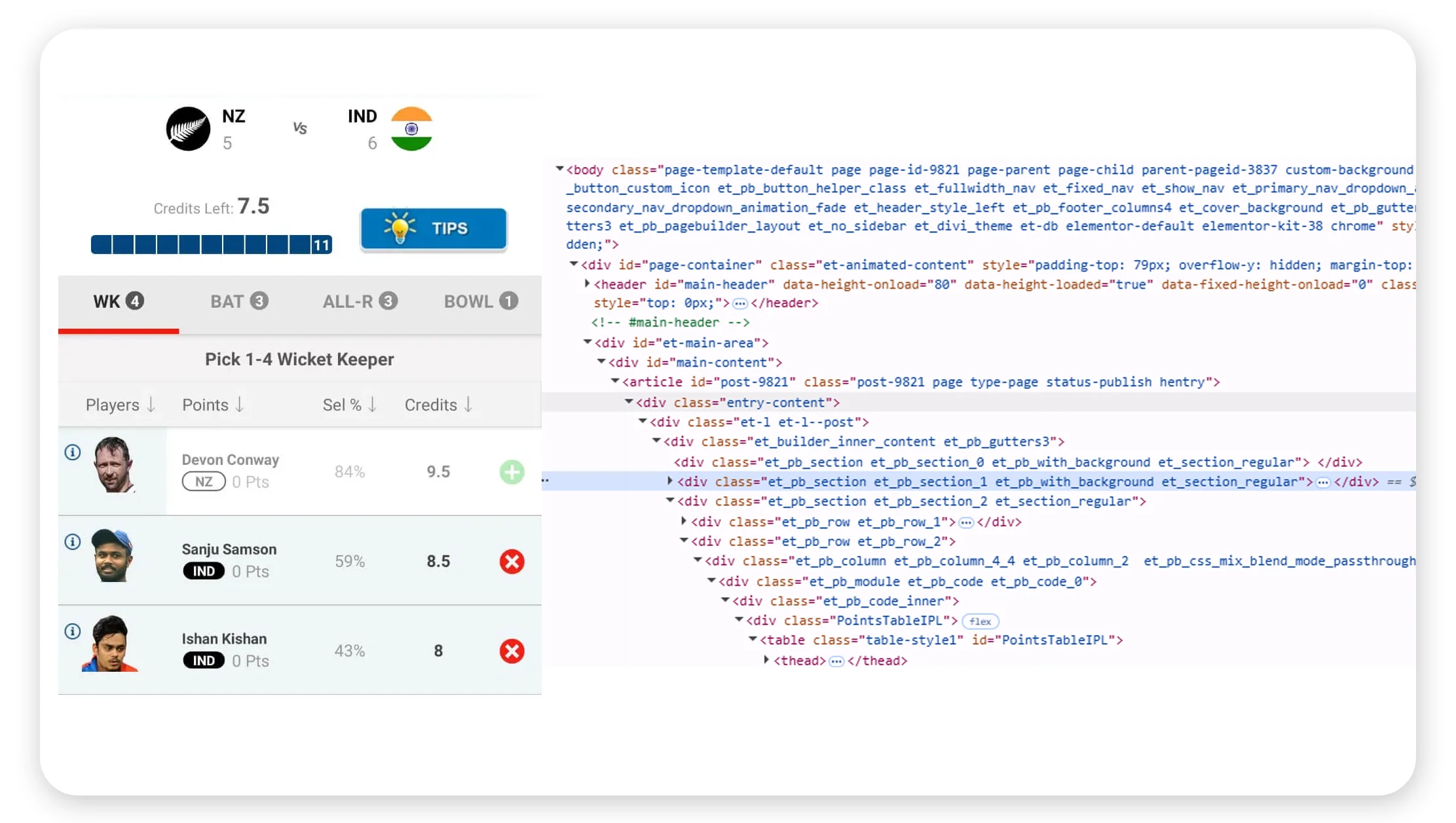
Gathering accurate and timely IPL data comes with several challenges that make the process more complex. These hurdles can significantly impact the efficiency and accuracy of data collection, especially for real-time analysis and decision-making.
1. Absence of a Public API
One of the most significant challenges in gathering IPL data is the lack of a public API. Many major sports leagues offer APIs that allow third-party services to fetch real-time data easily. However, IPL does not have an official API, which means that developers and analysts need to rely on web scraping techniques or other indirect methods to access the data. This increases the complexity of the process, requiring advanced scraping strategies to extract structured data.
2. Dynamic Content Loading (JavaScript-Heavy)
Many IPL-related websites and platforms load their content dynamically using JavaScript. This means that crucial data such as live scores, player statistics, and match summaries are rendered through JavaScript after the initial page load. Traditional web scraping tools may struggle to capture this dynamically loaded content, requiring more sophisticated solutions like headless browsers or scraping frameworks that can handle JavaScript-heavy pages.
3. Data Spread Across Multiple Platforms
IPL data is often spread across multiple platforms such as official IPL websites, sports news websites, and social media platforms. Gathering this data from various sources requires effective data aggregation tools to ensure the completeness of the information. Each platform may present data in different formats, further complicating the task of unifying the data into a single, accessible dataset for analysis.
4. Frequent Updates and Inconsistencies
Real-time IPL data is subject to frequent updates during matches, which makes it difficult to capture accurate snapshots of live statistics. As the data is constantly changing—particularly during high-stakes moments—scraping methods need to be quick and efficient to ensure that the information collected remains current. Furthermore, inconsistencies in the way data is presented across different sources can lead to discrepancies, requiring additional data cleaning and validation processes.
These challenges highlight the need for robust scraping techniques and advanced tools to capture IPL data efficiently and accurately. By using Python-based scraping methods and real-time data monitoring, analysts can overcome these issues and provide timely insights for various use cases.
Web Scraping IPL Data Using Python
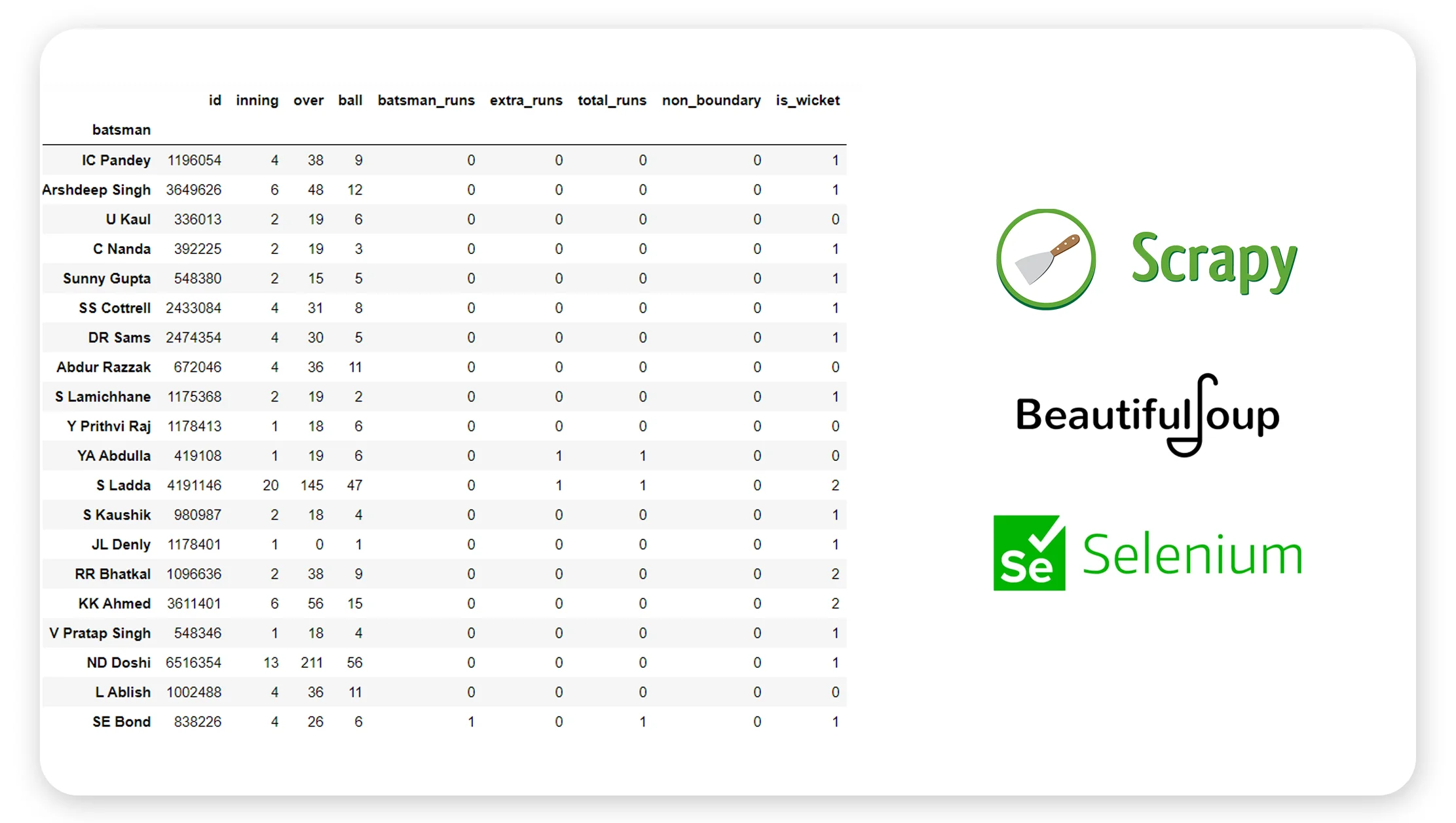
Web scraping IPL data using Python has become an essential technique for analysts and sports enthusiasts looking to extract real-time player and match statistics. With the right tools and libraries, you can automate the process of gathering valuable insights, such as player performance metrics and match outcomes, which are crucial for applications like fantasy leagues, betting, and sports journalism.
Tools & Libraries for Web Scraping IPL Data
- BeautifulSoup: This Python library is ideal for extracting data from static web pages. It parses HTML and XML documents, making it easy to navigate and search for specific data points. For scraping IPL data, BeautifulSoup is often used to parse the match statistics and player performance details embedded in HTML structure.
- Selenium: Selenium is a web testing tool that can also be used for web scraping, especially when dealing with dynamic content. It simulates a browser environment, which means it can interact with JavaScript-heavy websites to load and extract data that is rendered after the initial page load. Selenium is often combined with BeautifulSoup for seamless data extraction from interactive websites.
- Scrapy: Scrapy is an open-source web crawling framework that is efficient for large-scale scraping projects. It allows you to extract data from multiple pages simultaneously, offering powerful features like automated data export, request handling, and scheduling. Scrapy is often used for scraping IPL score prediction data, player stats, and historical match data from various sources.
Data Points Scraped
In the context of web scraping IPL Data, some of the key data points typically scraped include:
- Player Runs: The total number of runs scored by a player in each match.
- Wickets: The number of wickets taken by a bowler.
- Strike Rate: A key metric for batting performance that indicates the number of runs scored per 100 balls faced.
- Economy Rate: A bowler's average number of runs conceded per over.
- Match Stats: Information such as match scores, team performance, and other metrics relevant to fantasy platforms and analysts.
Steps to Scrape IPL Data Using Python
1. Target URLs: Identify the URLs containing the IPL match data, player statistics, or historical records. For example, IPL official websites or sports news platforms.
2. Parse HTML: Use libraries like BeautifulSoup or Scrapy to parse the HTML content of the page. This allows you to navigate through the structure and find the relevant data points.
3. Extract Data: After parsing the page, extract the required data points (runs, wickets, etc.) using selectors like CSS or XPath.
4. Store Data: Once the data is extracted, store it in a structured format like CSV, JSON, or a database (SQL/NoSQL) for further analysis and processing.
Legal & Ethical Considerations
When scraping IPL score prediction using Python or scraping player data using Python, it is crucial to ensure that the scraping activities comply with legal and ethical guidelines. Always check the website's robots.txt file to ensure you're not violating any terms of service or scraping restrictions. Data collected from public websites should be used for fair use, such as personal analysis or research, and not for commercial purposes without permission. Respect the platform’s policies and avoid excessive requests that may overload the server.
By leveraging these tools and practices, Python-based web scraping can be a powerful technique for gathering real-time IPL data and player insights, empowering analysts to deliver valuable reports and predictions.
Use Cases
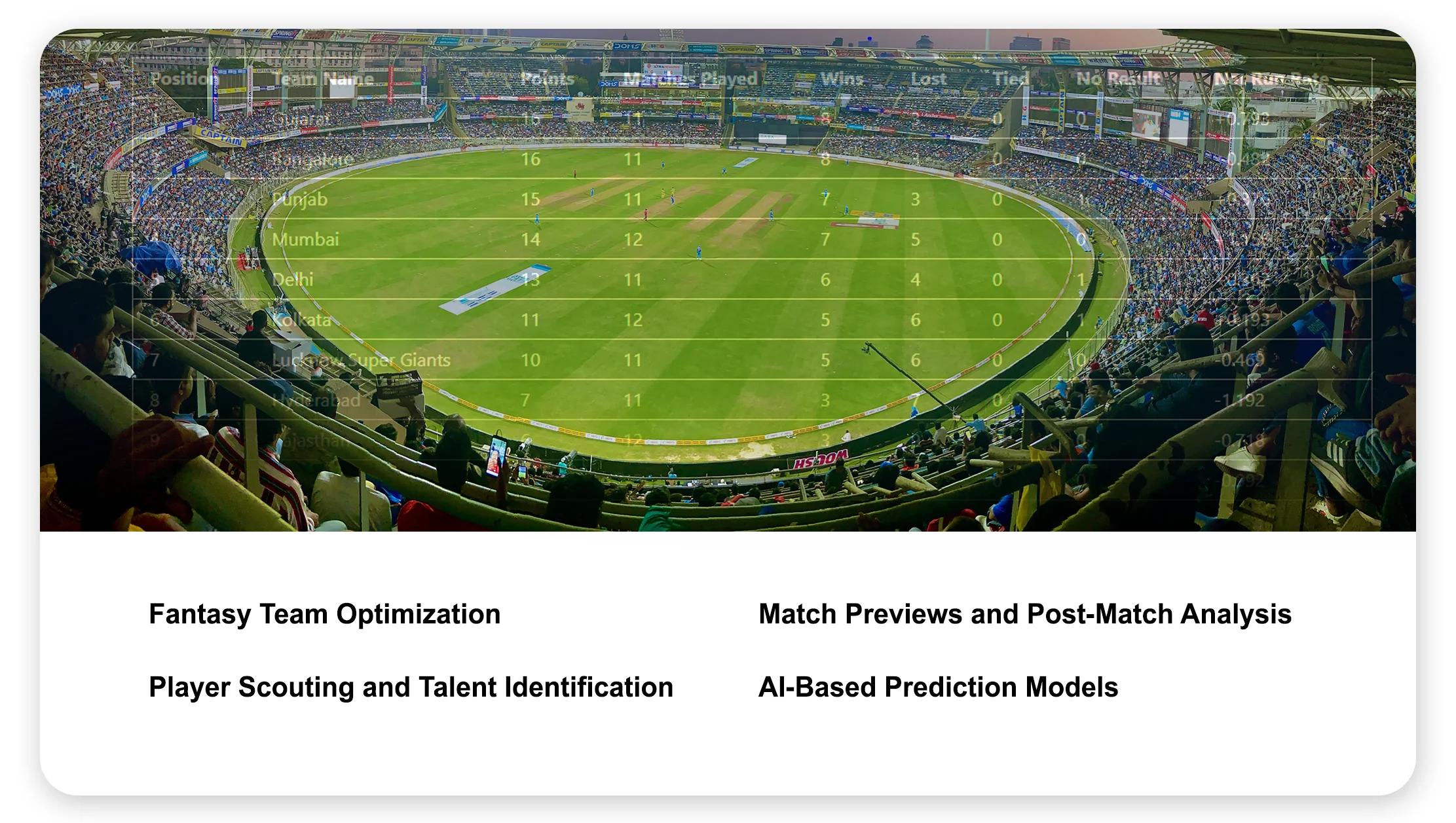
With the rising popularity of T20 leagues like the Indian Premier League (IPL), structured data plays a vital role in improving analysis, fan engagement, and strategic planning. By scraping IPL Data using Python, analysts and developers unlock multiple use cases across industries such as fantasy sports, AI development, sports journalism, and professional cricket management. Below are key applications:
Fantasy Team Optimization
For fantasy sports platforms, up-to-date player data is critical. By scraping live score Data, fantasy players can track performances in real-time—adjusting lineups based on a player's form, injury updates, or match conditions. Platforms can provide personalized suggestions by analyzing runs, wickets, and strike rates through dynamic player insights.
Player Scouting and Talent Identification
Scouts and analysts depend on accurate historical data to identify rising talent and potential future stars. Using an IPL Cricket Stats Scraper, performance data such as bowling economy, consistency in scores, and player impact across different pitch types can be extracted and structured for evaluation. This is especially useful for franchises or national selectors scouting domestic talents.
Match Previews and Post-Match Analysis
Journalists and broadcasters rely on deep match insights to build engaging previews and wrap-ups. By scraping IPL Data using Python, media teams can prepare content that includes key player matchups, recent form analysis, and statistics-driven narratives that enhance viewer experience.
AI-Based Prediction Models
Data scientists can train machine learning models for match result predictions, performance forecasting, or injury risk analysis. High-quality structured data gathered from IPL Cricket Stats Scraper tools forms the foundation of predictive analytics, enabling automated match insights that support fantasy gaming, betting, and fan engagement platforms.
Real Data API empowers web scraping IPL Data by offering robust, pre-built scraping pipelines targeting top platforms like ESPNcricinfo and Cricbuzz. These pipelines ensure fast and accurate extraction of live match details, player stats, and historical performance. With support for Web Scraping with Python, users can access data through scalable APIs, enabling seamless integration into analytics workflows, dashboards, and machine learning models. The system supports real-time updates with flexible refresh intervals, ensuring that data is always current. Real Data API’s structured delivery allows effortless connection to BI tools and custom Python scripts for powerful IPL data analysis and visualization.
Conclusion
Scraping and analyzing IPL data unlocks powerful insights for fantasy sports, media, betting platforms, and cricket strategists. From real-time score tracking to deep player performance analytics, structured data is a game-changer in today’s fast-paced sports landscape. Real Data API simplifies this process with scalable pipelines, seamless Web Scraping with Python, and real-time access to IPL statistics. By integrating this data into decision-making systems, businesses can enhance fan engagement, improve content delivery, and drive strategic advantage. Don’t miss the opportunity to tap into the potential of web scraping IPL Data—leverage Real Data API to stay ahead in the cricket analytics game.Tap into real-time cricket insights with Web Scraping IPL Data — powered by Real Data API!













